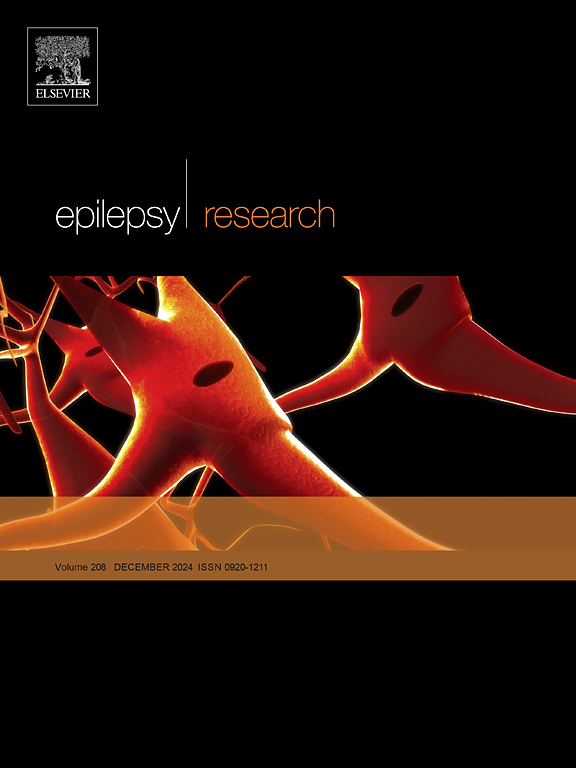White matter integrity and its correlation to seizures in diffuse glioma
IF 2
4区 医学
Q3 CLINICAL NEUROLOGY
引用次数: 0
Abstract
Introduction
Seizures are one of the most common symptoms in patients with diffuse glioma, occurring in 30–80 % of cases. Although seizure control can be achieved in up to 90 %, seizures remain a significant burden and are hardly predictable. The aim of this analysis was, therefore, to investigate the association between white matter integrity and seizure occurrence in patients with diffuse glioma using diffusion tensor imaging (DTI).
Methods
Patients with first diagnosis of diffuse glioma (WHO-grade 2, 3, 4) who received preoperative DTI sequences for surgical planning were analyzed. Tractography of corpus callosum and cingulum was carried out, extracting mean FA values of the resulting volumes.
Results
50 patients (17 female) were included with a mean age of 59.5 ± 2.2 years. Glioma WHO grade 4 was most common (82 %), followed by grade 3 (10 %) and grade 2 (8 %). Most gliomas were located left temporal (32 %) and bilateral frontal (each hemisphere 16 %). 16 % presented with multifocal glioma. 48 % had suffered seizures prior to surgery, and were thus diagnosed with structural epilepsy. 22 % of all patients presented recurring seizures despite surgery and anti-seizure medication, and 6 % developed new seizures after surgery. After correction for multiple comparisons, increased FA in the left parahippocampal cingulum was significantly associated with preoperative seizures (0.30 ± 0.01 versus 0.27 ± 0.01, pcorr = 0.007), while increased FA in the forceps minor of the corpus callosum correlated with postoperative seizures (0.49 ± 0.01 versus 0.43 ± 0.01, pcorr = 0.014).
Conclusion
Higher preoperative white matter integrity was associated with increased risk for occurrence of seizures in diffuse glioma. Further research is warranted to investigate the relation with tumor pathology.
弥漫性胶质瘤中白质完整性及其与癫痫发作的关系
癫痫发作是弥漫性胶质瘤患者最常见的症状之一,发生率为30 - 80% %。虽然癫痫发作控制可以达到90% %,但癫痫发作仍然是一个重大负担,很难预测。因此,本分析的目的是利用弥散张量成像(DTI)研究弥漫性胶质瘤患者白质完整性与癫痫发作之间的关系。方法对首次诊断为弥漫性胶质瘤(who分级2级、3级、4级)且术前接受DTI序列进行手术计划的患者进行分析。对胼胝体和扣带进行神经束造影,提取所得体积的平均FA值。结果纳入50例患者,其中女性17例,平均年龄59.5 ± 2.2岁。WHO 4级胶质瘤最常见(82% %),其次是3级(10 %)和2级(8 %)。大多数胶质瘤位于左侧颞叶(32 %)和双侧额叶(每个半球16 %)。16% %为多灶性胶质瘤。48% %手术前曾有癫痫发作,因此被诊断为结构性癫痫。22 %的患者在手术和抗癫痫药物治疗后出现复发性癫痫发作,6 %的患者在手术后出现新的癫痫发作。经多次校正比较,左侧海马旁扣带FA增加与术前癫痫发作显著相关(0.30 ± 0.01 vs 0.27 ± 0.01,pcorr = 0.007),胼胝体小钳FA增加与术后癫痫发作相关(0.49 ± 0.01 vs 0.43 ± 0.01,pcorr = 0.014)。结论弥漫性胶质瘤患者术前白质完整性增高与癫痫发作风险增加相关。值得进一步研究其与肿瘤病理的关系。
本文章由计算机程序翻译,如有差异,请以英文原文为准。
求助全文
约1分钟内获得全文
求助全文
来源期刊

Epilepsy Research
医学-临床神经学
CiteScore
0.10
自引率
4.50%
发文量
143
审稿时长
62 days
期刊介绍:
Epilepsy Research provides for publication of high quality articles in both basic and clinical epilepsy research, with a special emphasis on translational research that ultimately relates to epilepsy as a human condition. The journal is intended to provide a forum for reporting the best and most rigorous epilepsy research from all disciplines ranging from biophysics and molecular biology to epidemiological and psychosocial research. As such the journal will publish original papers relevant to epilepsy from any scientific discipline and also studies of a multidisciplinary nature. Clinical and experimental research papers adopting fresh conceptual approaches to the study of epilepsy and its treatment are encouraged. The overriding criteria for publication are novelty, significant clinical or experimental relevance, and interest to a multidisciplinary audience in the broad arena of epilepsy. Review articles focused on any topic of epilepsy research will also be considered, but only if they present an exceptionally clear synthesis of current knowledge and future directions of a research area, based on a critical assessment of the available data or on hypotheses that are likely to stimulate more critical thinking and further advances in an area of epilepsy research.
 求助内容:
求助内容: 应助结果提醒方式:
应助结果提醒方式:


